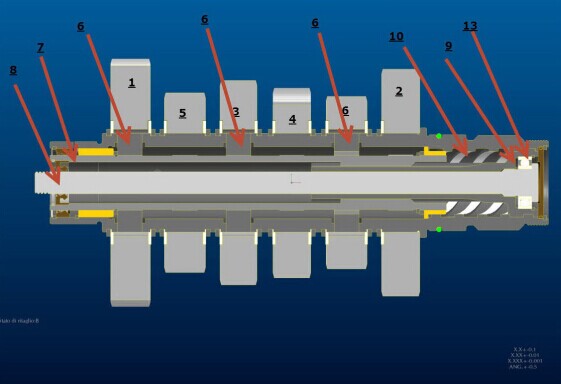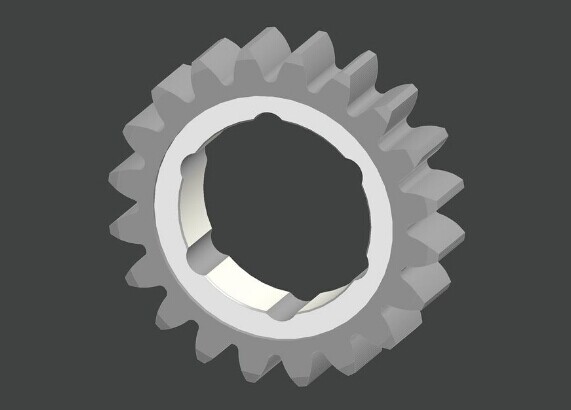 Automatic DCTs are a substantial advance in power transmission because, lacking the fluid losses of conventional torque converter automatics, they are more efficient. Yet they are complex and not always as quick-shifting as conventional automatics - and complexity easily translates into reduced efficiency.
Aroldo Tivelli thinks he has a better idea. I shall describe the compact, fast-shifting and efficient gearbox he designed and patented. It is compact because the usual shift-drum, shift forks, and fork guide rails are eliminated.
In a conventional 6-speed motorcycle gearbox, there are two shafts, each carrying six gears. Power enters on the primary shaft, is transmitted through one selected mesh to the other, secondary shaft, on one end of which is the output sprocket from which power goes by chain to the rear wheel. In neutral, one gear of each ratio pair is splined to its shaft and one spins freely. To engage a given ratio, the free-spinning gear of that pair must be locked to its shaft. This is accomplished by placing square engaging dogs on one face of the free-spinning gear and on the face of the splined gear next to it. That splined gear is able to slide axially on its splines, pushed by a shift fork which engages a slot made as part of that gear. To engage a ratio, the external shift linkage rotates the shift drum, whose cam slots slide one of the three shift forks to push the engaging dogs of the splined gear into engagement of those of the free-spinning gear. This creates a solid drive through that ratio only.
This system has served well for decades but the presence of shift drum, forks, and guide rails increases the bulk of the assembly by 50%, something that can be a problem when trying to tuck a gearbox up very close to an engine’s crankshaft in order to allow a desired engine position or the use of a longer swingarm.
Trivelli’s design places all gear selection mechanism inside the secondary shaft (10). The primary shaft is splined, as are the six gears it carries. All gears on the primary shaft are locked to it – none is free-spinning.
On the secondary shaft, all six gears are free-spinning except for when one of them is locked to it by three rectangular engaging pegs (shown as 6 in top image) projecting from rectangular radial holes in the shaft. The inside diameter of each gear (see image# 3 of 4) is provided with six corresponding arc-shaped recesses, spaced at 60-degrees from each other. To engage one of the six ratios, something inside the secondary shaft must push that gear’s engaging pegs outward against spring pressure, to lock into the arc-shaped recesses in that gear’s ID.
Automatic DCTs are a substantial advance in power transmission because, lacking the fluid losses of conventional torque converter automatics, they are more efficient. Yet they are complex and not always as quick-shifting as conventional automatics - and complexity easily translates into reduced efficiency.
Aroldo Tivelli thinks he has a better idea. I shall describe the compact, fast-shifting and efficient gearbox he designed and patented. It is compact because the usual shift-drum, shift forks, and fork guide rails are eliminated.
In a conventional 6-speed motorcycle gearbox, there are two shafts, each carrying six gears. Power enters on the primary shaft, is transmitted through one selected mesh to the other, secondary shaft, on one end of which is the output sprocket from which power goes by chain to the rear wheel. In neutral, one gear of each ratio pair is splined to its shaft and one spins freely. To engage a given ratio, the free-spinning gear of that pair must be locked to its shaft. This is accomplished by placing square engaging dogs on one face of the free-spinning gear and on the face of the splined gear next to it. That splined gear is able to slide axially on its splines, pushed by a shift fork which engages a slot made as part of that gear. To engage a ratio, the external shift linkage rotates the shift drum, whose cam slots slide one of the three shift forks to push the engaging dogs of the splined gear into engagement of those of the free-spinning gear. This creates a solid drive through that ratio only.
This system has served well for decades but the presence of shift drum, forks, and guide rails increases the bulk of the assembly by 50%, something that can be a problem when trying to tuck a gearbox up very close to an engine’s crankshaft in order to allow a desired engine position or the use of a longer swingarm.
Trivelli’s design places all gear selection mechanism inside the secondary shaft (10). The primary shaft is splined, as are the six gears it carries. All gears on the primary shaft are locked to it – none is free-spinning.
On the secondary shaft, all six gears are free-spinning except for when one of them is locked to it by three rectangular engaging pegs (shown as 6 in top image) projecting from rectangular radial holes in the shaft. The inside diameter of each gear (see image# 3 of 4) is provided with six corresponding arc-shaped recesses, spaced at 60-degrees from each other. To engage one of the six ratios, something inside the secondary shaft must push that gear’s engaging pegs outward against spring pressure, to lock into the arc-shaped recesses in that gear’s ID.
 That “something inside the shaft” is the selector camshaft (7), on whose outside diameter are six sets of cam bumps, staggered so that only a single set at a time can push outward its corresponding engaging pegs to engage a ratio. Gear selection is now accomplished by rotating the camshaft (7) in relation to the secondary shaft (10), thereby pushing out only the one desired set of engaging pegs.
This in turn is accomplished by yet a third concentric shaft (8, also seen in image# 1 of 4), located inside the camshaft (7). This 3rd shaft, the actuator shaft (8), carries a straight spline on one end which engages a matching spline inside the actuator cam shaft 7). This shaft (8) can move axially, and at one end of it is a helical spine which engages a matching helical spline cut into the ID of the secondary shaft at one of its ends.
If this doubly-splined actuator shaft (8) (with straight spline on one end, locking it to the selector camshaft (7), helical spline on the other end, engaging a matching spline inside the secondary shaft) is moved axially, its helical spline causes the camshaft (7) to rotate, engaging sequentially 1st, 2nd, 3rd gear and so on. Thus, each axial position of this inner actuator shaft (8) corresponds to one of the six ratios or to neutral.
Since the engine was an overgrown 50-cc unit, that very efficient gearbox was also very light so reliability could be a problem if it were abused. Yet if properly managed it made the Sachs 125 hard to beat.
At the time, Dr. Trivelli was owner and project engineer of Tau Motori and his Tau 125 engine was one of the most capable (I used to dyno each bike so I know first-hand), but still had a very hard time beating the Sachs 125. Trivelli never forgot that and finally came up with this concept, variations of which – some with dual clutch - are suitable for future motorcycle or car applications.
That “something inside the shaft” is the selector camshaft (7), on whose outside diameter are six sets of cam bumps, staggered so that only a single set at a time can push outward its corresponding engaging pegs to engage a ratio. Gear selection is now accomplished by rotating the camshaft (7) in relation to the secondary shaft (10), thereby pushing out only the one desired set of engaging pegs.
This in turn is accomplished by yet a third concentric shaft (8, also seen in image# 1 of 4), located inside the camshaft (7). This 3rd shaft, the actuator shaft (8), carries a straight spline on one end which engages a matching spline inside the actuator cam shaft 7). This shaft (8) can move axially, and at one end of it is a helical spine which engages a matching helical spline cut into the ID of the secondary shaft at one of its ends.
If this doubly-splined actuator shaft (8) (with straight spline on one end, locking it to the selector camshaft (7), helical spline on the other end, engaging a matching spline inside the secondary shaft) is moved axially, its helical spline causes the camshaft (7) to rotate, engaging sequentially 1st, 2nd, 3rd gear and so on. Thus, each axial position of this inner actuator shaft (8) corresponds to one of the six ratios or to neutral.
Since the engine was an overgrown 50-cc unit, that very efficient gearbox was also very light so reliability could be a problem if it were abused. Yet if properly managed it made the Sachs 125 hard to beat.
At the time, Dr. Trivelli was owner and project engineer of Tau Motori and his Tau 125 engine was one of the most capable (I used to dyno each bike so I know first-hand), but still had a very hard time beating the Sachs 125. Trivelli never forgot that and finally came up with this concept, variations of which – some with dual clutch - are suitable for future motorcycle or car applications.
Next Thomson Expands Miniature Metric Ball Nut Styles
BRIEF INTRODUCTION
Cnbearing is the No.1 bearing inquiry system and information service in China, dedicated to helping all bearing users and sellers throughout the world.
Cnbearing is supported by China National Bearing Industry Association, whose operation online is charged by China Bearing Unisun Tech. Co., Ltd.
China Bearing Unisun Tech. Co., Ltd owns all the rights. Since 2000, over 3,000 companies have been registered and enjoyed the company' s complete skillful service, which ranking many aspects in bearing industry at home and abroad with the most authority practical devices in China.
